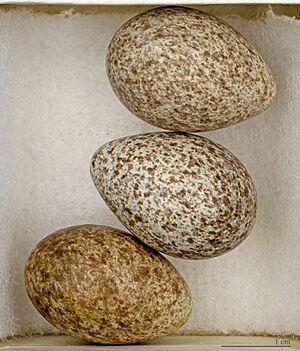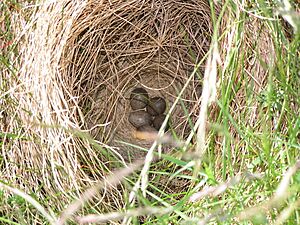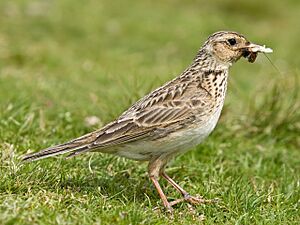Eurasian skylark facts for kids
Quick facts for kids Eurasian skylark |
|
|---|---|
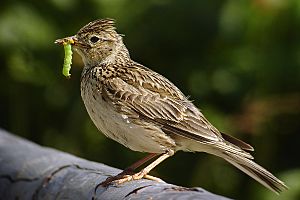 |
|
| With caterpillar caught in beak | |
| Conservation status | |
| Scientific classification | |
| Genus: |
Alauda
|
| Species: |
arvensis
|
| Subspecies | |
|
See text |
|
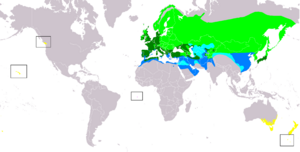 |
|
| Range of A. arvensis Breeding Resident Passage Non-breeding Extant & Introduced (resident) Possible extinct & Introduced | |
The Eurasian skylark (Alauda arvensis) is a type of songbird in the lark family. These birds are found all over Europe and a large part of Asia. You can also find them in places like Australia, New Zealand, and Hawaii, where they were brought by people.
Skylarks love open areas like farms and grassy fields. They are famous for the amazing songs sung by the male birds. They sing while flying high in the sky, sometimes 50 to 100 meters up! Both male and female skylarks look similar. They are brownish-grey with streaks on their backs and chests. Their bellies are a lighter, creamy-white color.
Female Eurasian skylarks build their nests on the ground. They make a shallow dip and line it with grass. They usually lay three to five eggs. The mother bird sits on the eggs for about 11 days until they hatch. Both parents feed the baby birds. The young birds leave the nest after about eight to ten days, even before they can fly well. They hide in the plants and are still fed by their parents until they can fly at 18 to 20 days old. Many nests are eaten by bigger birds or small animals. Skylark parents can have several groups of babies in one year.
Contents
Discovering the Eurasian Skylark
The Eurasian skylark was first officially described by a Swedish scientist named Carl Linnaeus in 1758. He gave it the scientific name Alauda arvensis. This name is still used today. The word Alauda comes from a Latin word for "lark." The word arvensis is also Latin and means "of the field."
Scientists have studied the lark family using DNA (a molecular phylogenetic study). They found that the Eurasian skylark is most closely related to the Oriental skylark. Sometimes, the Japanese skylark is thought of as a separate type, but usually, it's considered a kind of Eurasian skylark.
Different Types of Skylarks
There are many different kinds of Eurasian skylarks, called subspecies. These different types live in various parts of the world. For example, one type lives in northern and western Europe, while others are found in places like Spain, Africa, Turkey, China, and Japan. These subspecies have small differences, often in their size or color, depending on where they live.
What Does a Eurasian Skylark Look Like?
The Eurasian skylark is about 18 to 19 centimeters long. Like most larks, it's not super colorful. It's mostly brown on top and lighter underneath. It has a small, blunt crest on its head that it can raise or lower. When it flies, you can see its short tail and wide wings. The edges of its tail and wings are white. This white part is easy to see when the bird flies away from you. Male skylarks have wider wings than females. This helps them hover in the air more easily. This might have developed because female skylarks like males that sing and hover for longer. This shows the male is strong and healthy.
The male skylark is famous for its song. It sings while hovering high in the sky, sometimes so high it looks like just a tiny dot. The song is long and continuous, a clear, bubbly sound. It sings while rising, circling, or just staying in one spot in the air. The song usually lasts two to three minutes. But later in the mating season, it can last for 20 minutes or even longer!
Where Do Eurasian Skylarks Live?
These larks breed across most of Europe and Asia. They also live in the mountains of North Africa. In the western parts of their home range, they usually stay in the same place all year. But birds in eastern areas travel south for the winter. Even in warmer western areas, many birds move to lower lands and the coast when it gets cold.
Skylarks in New Places
People have brought Eurasian skylarks to new places around the world.
- New Zealand: In the 1800s, skylarks were brought to New Zealand. They quickly grew in number and spread across both the North and South Islands by the 1920s.
- Australia: Skylarks were also introduced to Australia starting in 1850. Now, they are common in the southeastern part of the country, including Victoria, Tasmania, and parts of South Australia.
- Hawaiian Islands: They were brought to Hawaii in 1865. While they used to be common, their numbers have gone down on some islands. By 1986, most were found only on the islands of Hawaii and Maui.
- Vancouver Island, Canada: Skylarks were brought to Vancouver Island in 1903. Their population grew, but then it started to shrink because they lost their natural homes. Today, there are only about 100 skylarks left in a few small areas there.
Life Cycle and Habits
Reproduction
Eurasian skylarks usually start having babies when they are one year old. They begin nesting in late March or early April. The female bird likely builds the nest herself. It's a shallow dip in the ground, lined with grass. She lays 3 to 5 eggs. The eggs are about 2.3 cm by 1.7 cm and weigh around 3.35 grams. They are grey-white or greenish with brown or olive spots.
The female sits on the eggs, and they all hatch at about the same time after 11 days. Both parents take care of the young birds. For the first week, the babies eat mostly insects. The young birds can fly after 18 to 20 days. However, they usually leave the nest after only 8 to 10 days. They hide in the plants and are still fed by their parents until they are about 25 days old. Skylark parents can have up to 4 groups of babies in one season!
What Do Skylarks Eat?
Eurasian skylarks walk on the ground, looking for food on the soil surface. They eat insects and parts of plants, like seeds and young leaves. Unlike some other birds, they swallow seeds whole, without taking off the outer shell. Insects are a very important part of their diet in the summer.
Challenges for Skylarks
In the UK, the number of Eurasian skylarks has gone down since the 1970s. This is mainly because of changes in farming. In the past, farmers planted grains in the spring and harvested them in the autumn. This left open fields where skylarks could find food. Now, many farmers plant grains in the autumn. These fields grow very thick in the winter and summer. It becomes too hard for skylarks to walk between the plants to find their food.
Groups like the RSPB (Royal Society for the Protection of Birds) are working to help skylarks. Farmers in England are now encouraged and paid to create better homes for skylarks. For example, they can choose to plant grains in the spring instead of the autumn. They can also leave the leftover plant stalks (stubble) in the fields over winter. This stubble acts like a "giant bird table," providing leftover grains and weed seeds for birds to eat.
Skylarks in Culture
When people just say "lark," they usually mean the Eurasian skylark. A special word for a group of skylarks is an "exaltation." This word has been used for a very long time, since the 1400s! The word "skylark" can also be a verb, meaning to "play tricks" or "have fun." Sailors used this word first.
The skylark has inspired many famous poems and pieces of music. For example, the poets Percy Bysshe Shelley and George Meredith wrote poems about them. The famous music piece The Lark Ascending by Ralph Vaughan Williams was inspired by a poem about this bird. The skylark is also the bird symbol for Kumamoto Prefecture in Japan.



